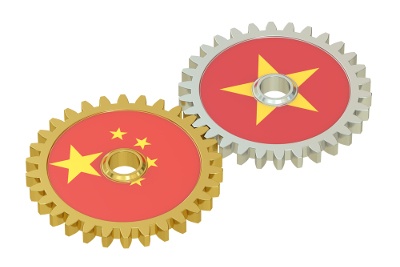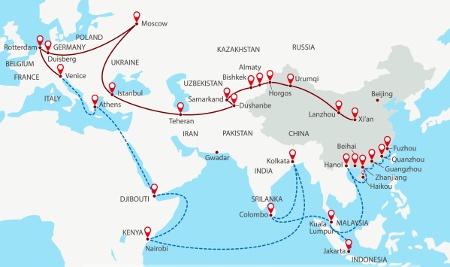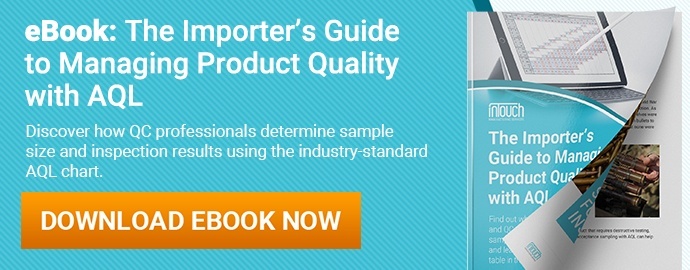Best in Manufacturing – April 15, 2018
Each Sunday, we publish a list of top articles and other content related to manufacturing in areas like quality control, product development, supply chain management, sourcing, auditing and law.
1. The misconceptions misleading your supply chain
Who doesn’t want to optimize their supply chain?
Of course, just about everyone wants a better supply chain. But this task is easier said than done.
 The author of this featured article mentions several errors that companies succumb to when pursuing supply chain improvements. The below examples aren’t relevant to every company. But there’s some that might apply to your situation:
The author of this featured article mentions several errors that companies succumb to when pursuing supply chain improvements. The below examples aren’t relevant to every company. But there’s some that might apply to your situation:
- Blockchain will help with supply chain traceability
- Improved forecasting will help with managing inventory levels
- Functional excellence will help companies “win”
- And more
Let’s look at the first misconception more closely. Blockchain is exploding in popularity, mostly in part due to cyber currencies like Bitcoin. Another area of use, for supply chains specifically, is in the form of improving visibility.
Consumers, for instance, can view a blockchain to see where their products were manufactured. Because there’s an unalterable digital handshake at each stage of the supply chain, they’ll be able to see where and when goods changed hands.
But what if the information supplied at that exchange was falsified? That would place the legitimacy and value of blockchain and all those digital handshakes in question.
Blockchain in global supply chains is just one example of a fallacy that might be affecting your improvement efforts. To learn about the others, check out the full article in the link below:
The Biggest Supply Chain Fallacies - Steve Banker, Forbes
2. Geckos and robotics
Geckos. What on Earth could they have to do with robotics?
Believe it or not, geckos are great to study for robotics applications because of their special toes. Geckos are able to rely on their toes to climb very well in nature due to having “microscopic hairs that are up to 30 times smaller [emphasis added] than a human hair”.
Researchers from the University of California, San Diego took this characteristic and applied it to robot fingers so that they have better grip. Emulating nature for improvements to technology is a classic case of biomimicry (see #5).
The featured article mentions that the gecko grip technology will probably first make an appearance on the International Space Station for use in zero-gravity applications. It’s anyone’s guess as to how long it will take for the technology to make it to robots on factory production lines. But if you’d like to see gecko grip in action, check out the featured article and accompanying video in the link below:
Robotic Grippers Given Gecko Toes - David Mantey, ThomasNet.com
3. Vietnam as an alternative to China for manufacturing
For many international firms, China is the go-to destination for outsourcing production. Yet it’s not the only country in Asia worthy of attention.
 There are certainly alternatives to sourcing from China. And as explained by this featured article, one of those alternatives is Vietnam.
There are certainly alternatives to sourcing from China. And as explained by this featured article, one of those alternatives is Vietnam.
Vietnam offers a few advantages:
- Competitive labor rates
- 74 percent of the labor force (see #5) is less than 50 years old
- Close proximity to China
- Involvement in several trade agreements (e.g., ASEAN, the Trans Pacific Partnership)
The value of these trade agreements is so significant, the author mentions,
Finally, and perhaps most importantly, Vietnam’s network of trade agreements is among the best that manufacturers will be able to find in a country at this point on the value chain. Vietnam, unlike China which has historically used its low wages and large size to boost export competitiveness, has a wide network of trade agreements extending to key import markets across the globe.
Despite these advantages, it might not make sense for importers to move all operations to Vietnam instantaneously. For the garment industry, for example, it might be wise to completely relocate manufacturing to Vietnam. But for other industries, it might be best to augment your supply chain with only a few products or components from Vietnam.
Importers ultimately need to decide if the smartest option is to relocate none, only some or all of their supply chain to Vietnam. At the very least, in light of Vietnam’s advantages, it may be a choice worth considering. Or maybe, China will continue to reign supreme for manufacturing (see #5), and a move won’t be necessary.
To read more about manufacturing in Vietnam, check out the article in the link below:
China+1: The New Face of Manufacturing in Vietnam - Maxfield Brown, Vietnam Briefing via Dezan Shira & Associates
4. Why middlemen are on their way out of supply chains
The verdict is in: blockchain-enabled digital platforms are in and middlemen are out.
Before the digital age, middlemen used to be essential to supply chain management. It was difficult to find suppliers, shippers and retailers without a broker who possessed a hub of contacts. Of course, in exchange for creating connections between brands and suppliers, brokers would charge a fee.
Now, you can look anyone up on the internet, whether that’s on Facebook or Alibaba. But supply chain management has lagged behind other industries in increasing efficiency through digitization. This featured article focuses on shipping brokers, citing a few key stats of the inefficiency and fragmentation of the current shipping industry:
- 67 percent of all shippers (i.e. brands who need merchandise moved) rely on paper records
- Shipping brokers typically take a 15-20 percent commission on each load, and book, on average, only about 3-4 deals per day
- The top 20 brokers in the shipping industry generate only 4 percent of the industry’s revenue
Most shipping brokers are small operations, with a limited number of connections, unknown to potential customers who need their services. And many trucks on the road are empty as they travel from one drop-off location to another pick-up location.
Where does blockchain come in then? Blockchain-enabled digital platforms allow brands and shippers to find each other and make peer-to-peer payments, all without a middleman.
Fr8 Network is one such digital platform featured in this article. The system runs on Fr8 tokens, a cryptocurrency, which users must put up as collateral to ensure completion of an agreed-upon transaction. This ensures transparent and responsible use of the platform and protects everyone involved.
Do you think digital platforms can eliminate middlemen in the supply chain (or are they already?). Share your thoughts in the comment section below and follow the link below to learn more:
Why There’s No Longer Room for Middle Men in Supply Chain Management – Editorial Staff, Bitcoinist.net
5. The progress of the Belt and Road Initiative
OBOR, or the “One Belt, One Road” initiative led by the Chinese government, developed significantly in 2017 (see #3). But looking further back, from the start of OBOR until now, how has Beijing’s plan to improve trade and geopolitical ties through investments in infrastructure really manifested?
This featured article essentially provides a progress report on OBOR. After surveying projects in or around Bangladesh, India, Indonesia, Kazakhstan, Laos, Pakistan, Poland and Sri Lanka, the article provides a few important considerations about OBOR:
- Project delays: not all projects are on schedule, like those in Indonesia, Kazakhstan and Bangladesh
- Increasing debts owed to China: several countries are worried about the piles and piles of money they owe to their Chinese benefactors
- Concerns about sovereignty: China took over the port of Hambantota in Sri Lanka (in the form of a 99-year lease). India is upset about projects underway between its regional rival, Pakistan, and China
Regardless of these issues, Beijing continues to dispense cash to fund its massive OBOR initiative. Officials there will not listen to outsider criticism in pursuit of what they want. There are still countless projects underway that are scattered across Asia, in the form of hydropower plants, rail lines, ports and more. It’s a safe bet that these projects show no sign of stopping permanently.
Curious about more facts and figures regarding OBOR in Asia? Check out the detailed article in the link below for more information:
Is China's Belt and Road working? A progress report from eight countries - Go Yamada and Stefania Palma, Nikkei Asian Review
We’re constantly scanning the web for top manufacturing stories and news. If you’d like to submit an article for consideration for our weekly Best in Manufacturing, send us a message and let us know.







